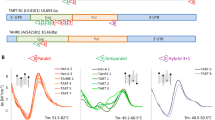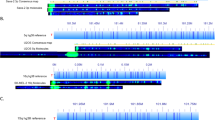Abstract
Previously, we described the unique feature of telomeric regions in Iberian shrew Sorex granarius: its telomeres have two ranges of size, very small (3.8 kb of telomeric repeats on average) and very large discontinuous telomeres (213 kb) interrupted with 18S rDNA. In this study, we have demonstrated extraordinary replication pattern of S. granarius large telomeres that have not been shown before in other studied mammal. Using the ReD-FISH procedure, we observed prolonged, through S period, large telomere replication. Furthermore, revealed ReD-FISH asymmetric signals were probably caused by partial replication of telomeres within an hour of 5-bromodeoxyuridine treatment due to the large size and special organization. We also found that in contrast to the telomeric halo from primary fibroblasts of bovine, mink, and common shrew, telomere halo of S. granarius consists of multiple loops bundled together, some of which contain rDNA. Here, we suggested several replicons firing possibly stochastic in each large telomere. Finally, we performed the TIF assay to reveal DNA damage responses at the telomeres, and along with TIF in nuclei, we found large bodies of telomeric DNA and ɤ-H2AX in the cytoplasm and on the surface of fibroblasts. We discuss the possibility of additional origin activation together with recombination-dependent replication pathways, mainly homologous recombination including BIR for replication fork stagnation overcoming and further S. granarius large telomere replication.




Similar content being viewed by others
Abbreviations
- FISH:
-
Fluorescence in situ hybridization
- ReD-FISH:
-
Replication detargeting FISH
- CO-FISH:
-
Chromosome-oriented FISH
- PNA probe:
-
Peptide nucleic acid probe
- FACS:
-
Fluorescence-activated cell sorting
- TIF:
-
Telomere dysfunction-induced foci
- HR:
-
Homologous recombination
- BIR:
-
Break-induced replication
References
Anachkova B, Djeliova V, Russev G (2005) Nuclear matrix support of DNA replication. J Cell Biochem 96(5):951–961. https://doi.org/10.1002/jcb.20610
Arnoult N, Schluth-Bolard C, Letessier A, Drascovic I, Bouarich-Bourimi R, Campisi J, Kim SH, Boussouar A, Ottaviani A, Magdinier F, Gilson E, Londoño-Vallejo A (2010) Replication timing of human telomeres is chromosome arm-specific, influenced by subtelomeric structures and connected to nuclear localization. PLoS Genet 6(4):e1000920. https://doi.org/10.1371/journal.pgen.1000920
Biltueva L, Vorobieva N, Perelman P, Trifonov V, Volobouev V, Panov V, Ilyashenko V, Onischenko S, O’Brien P, Yang F, Ferguson-Smith M, Graphodatsky A (2011) Karyotype evolution of Eulipotyphla (Insectivora): the genome homology of seven Sorex species revealed by comparative chromosome painting and banding data. Cytogenet Genome Res 135(1):51–64. https://doi.org/10.1159/000330577
Blow JJ, Ge XQ (2008) Replication forks, chromatin loops and dormant replication origins. Genome Biol 9(12):244. https://doi.org/10.1186/gb-2008-9-12-244
Bosco G, Haber JE (1998) Chromosome break-induced DNA replication leads to nonreciprocal translocations and telomere capture. Genetics 150(3):1037–1047
Buongiorno-Nardelli M, Micheli G, Carri MT, Marilley M (1982) A relationship between replicon size and supercoiled loop domains in the eukaryotic genome. Nature 298(5869):100–102
Conomos D, Stutz MD, Hills M, Neumann AA, Bryan TM, Reddel RR, Pickett HA (2012) Variant repeats are interspersed throughout the telomeres and recruit nuclear receptors in ALT cells. J Cell Biol 199(6):893–906. https://doi.org/10.1083/jcb.201207189
Courbet S, Gay S, Arnoult N, Wronka G, Anglana M, Brison O, Debatisse M (2008) Replication fork movement sets chromatin loop size and origin choice in mammalian cells. Nature 455(7212):557–560. https://doi.org/10.1038/nature07233
Darzynkiewicz Z, Halicka HD, Zhao H, Podhorecka M (2011) Cell synchronization by inhibitors of DNA replication induces replication stress and DNA damage response: analysis by flow cytometry. Methods Mol Biol 761:85–96. https://doi.org/10.1007/978-1-61779-182-6_6
Drosopoulos WC, Kosiyatrakul ST, Yan Z, Calderano SG, Schildkraut CL (2012) Human telomeres replicate using chromosomes specific, rather than universal, replication programs. J Cell Biol 197(2):253–266. https://doi.org/10.1083/jcb.201112083
Drosopoulos WC, Kosiyatrakul ST, Schildkraut CL (2015) BLM helicase facilitates telomere replication during leading strand synthesis of telomeres. J Cell Biol 210(2):191–208. https://doi.org/10.1083/jcb.201410061
Elcock LS, Bridger JM (2010) Fluorescence in situ hybridization on DNA halo preparations and extended chromatin fibres. Methods Mol Biol 659:21–31. https://doi.org/10.1007/978-1-60761-789-1_2
Gerdes MG, Carter KC, Moen PT Jr, Lawrence JB (1994) Dynamic changes in the higher-level chromatin organization of specific sequences revealed by in situ hybridization to nuclear halos. J Cell Biol 126(2):289–304
Gilson E, Geli V (2007) How telomeres are replicated. Nat Rev Mol Cell Biol 8:825–838. https://doi.org/10.1038/nrm2259
Halicka D, Zhao H, Li J et al (2017) DNA damage response resulting from replication stress induced by synchronization of cells by inhibitors of DNA replication: analysis by flow cytometry. Cell Cycle Synchronization: Methods Protoc 1524:107–119. https://doi.org/10.1007/978-1-4939-6603-5_7
Kim JC, Harris ST, Dinter T, Shah KA, Mirkin SM (2017) The role of break-induced replication in large-scale expansions of (CAG)n/(CTG)n repeats. Nat Struct Mol Biol 24:55–60. https://doi.org/10.1038/nsmb.3334
Kipling D, Cooke HJ (1990) Hypervariable ultra-long telomeres in mice. Nature 347(6291):400–402. https://doi.org/10.1038/347400a0
Llorente B, Smith CE, Symington LS (2008) Break-induced replication: what is it and what is it for? Cell Cycle 7:859–864. https://doi.org/10.4161/cc.7.7.5613
Londono-Vallejo JA, Der-Sarkissian H, Cazes L et al (2004) Alternative lengthening of telomeres is characterized by high rates of telomeric exchange. Cancer Res 64(7):2324–2327. https://doi.org/10.1158/0008-5472
Lydeard JR, Lipkin-Moore Z, Sheu YJ, Stillman B, Burgers PM, Haber JE (2010) Break-induced replication requires all essential DNA replication factors except those specific for pre-RC assembly. Genes Dev 24(11):1133–1144. https://doi.org/10.1101/gad.1922610
Malygin AA, Graĭfer DM, Zenkova MA et al (1992) Affinity modification of 80S ribosomes from human placenta by derivatives of tri- and hexauridylates as mRNA analogs. Mol Biol (Mosk) 26(2):369–377
Martin M, Terradas M, Hernandez L, Genesca A (2014) ɤH2AX foci on apparently intact mitotic chromosomes: not signatures of misrejoining events but signals of unresolved DNA damage. Cell Cycle 13(19):3026–3036. https://doi.org/10.4161/15384101.2014.947786
Matsui A, Ihara T, Suda H, Mikami H, Semba K (2013) Gene amplification: mechanisms and involvement in cancer. BioMol Concepts 4(6):567–582. https://doi.org/10.1515/bmc-2013-0026
Nakamura H, Morita T, Sato C (1986) Structural organizations of replicon domains during DNA synthetic phase in the mammalian nucleus. Exp Cell Res 165(2):291–297
Olovnikov AM (1973) A theory of marginotomy: the incomplete copying of template margin in enzymic synthesis of polynucleotides and biological significance of the phenomenon. J Theor Biol 41(1):181–190
Raghuraman MK, Winzeler EA, Collingwood D, Hunt S, Wodicka L, Conway A, Lockhart DJ, Davis RW, Brewer BJ, Fangman WL (2001) Replication dynamics of the yeast genome. Science 294(5540):115–121. https://doi.org/10.1126/science.294.5540.115
Razin SV (2001) The nuclear matrix and chromosomal DNA loops: is there correlation between partitioning of the genome into loops and functional domains? Cell Mol Biol Lett 6(1):59–69
Rhind N (2006) DNA replication timing: random thoughts about origin firing. Nat Cell Biol 8(12):1313–1316. https://doi.org/10.1038/ncb1206-1313
Rivera-Mulia JC, Hernandez-Muñoz R, Martinez F, Aranda-Anzaldo A (2011) DNA moves sequentially towards the nuclear matrix during DNA replication in vivo. BMC Cell Biol 12(3):3. https://doi.org/10.1186/1471-2121-12-3
Rogakou EP, Pilch DR, Orr AH, Ivanova VS, Bonner WM (1998) DNA double stranded breaks induce histone H2AX phosphorylation on serine 139. J Biol Chem 273(10):5858–5868
Rosner M, Schupany K, Hengstschlager M (2013) Merging high-quality biochemical fractionation with a refined flow cytometry approach to monitor nucleocytoplasmic protein expression throughout the unperturbed mammalian cell cycle. Nat Protoc 8:602–626. https://doi.org/10.1038/nprot.2013.011
Roumelioti FM, Sotiriou SK, Katsini V, Chiourea M, Halazonetis TD, Gagos S (2016) Alternative lengthening of human telomeres is a conservative DNA replication process with features of break-induced replication. EMBO Rep 17(12):1731–1737. https://doi.org/10.15252/embr.201643169
Rubtsov NB, Zhdanova NS (2017) The replicative detargeting FISH (ReD-FISH) technique in studies of telomere replication. In: Liehr T (ed) Fluorescence in situ hybridization (FISH): Application guide. Springer, pp 159–168. https://doi.org/10.1007/978-3-662-52959-1_16
Sakofsky CJ, Malkova A (2017) Break induced replication in eukaryotes: mechanisms, functions, and consequences. Crit Rev Biochem Mol Biol 52(4):395–413. https://doi.org/10.1080/10409238.2017.1314444
Samassekou O, Gadji M, Drouin R, Yan J (2010) Sizing the ends: normal length of human telomeres. Ann Anat 192(5):284–291. https://doi.org/10.1016/j.aanat.2010.07.005
Sobinoff AP, Pickett HA (2017) Alternative lengthening of telomeres: DNA repair pathways converge. Trends Genet 33(12):921–932. https://doi.org/10.1016/j.tig.2017.09.003
Tacconi EM, Tarsounas M (2015) How homologous recombination maintains telomere integrity. Chromosoma 124(2):119–130. https://doi.org/10.1007/s00412-014-0497-2
Vaughn JP, Dijkwel PA, Mullenders LH, Hamlin JL (1990) Replication forks are associated with the nuclear matrix. Nucleic Acids Res 18(8):1965–1969
Wiegant J, Kalle W, Mullenders L, Brookes S, Hoovers JMN, Dauwerse JG, van Ommen GJB, Raap AK (1992) High-resolution in situ hybridization using DNA halo preparations. Hum Mol Genet 1(8):587–591
Zhdanova NS, Karamisheva TV, Minina J, Astakhova NM, Lansdorp P, Kammori M, Rubtsov NB, Searle JB (2005) Unusual distribution pattern of telomeric repeats in the shrews Sorex araneus and Sorex granarius. Chromosom Res 13(6):617–625. https://doi.org/10.1007/s10577-005-0988-3
Zhdanova NS, Minina JM, Karamisheva TV, Draskovic I, Rubtsov NB, Londoño-Vallejo JA (2007) The very long telomeres in Sorex granarius (Soricidae, Eulipothyphla) contain ribosomal DNA. Chromosom Res 15(7):881–890. https://doi.org/10.1007/s10577-007-1170-x
Zhdanova NS, Minina JM, Rubtsov NB (2012) Mammalian telomere biology. Mol Biol (Mosk) 46(4):539–555
Zhdanova NS, Draskovic I, Minina JM, Karamysheva TV, Novo CL, Liu WY, Porreca RM, Gibaud A, Zvereva ME, Skvortsov DA, Rubtsov NB, Londono-Vallejo A (2014) Recombinogenic telomeres in diploid fibroblast cells Sorex granarius (Soricidae, Eulipotyphla). Mol Cell Biol 34(15):2786–2799. https://doi.org/10.1128/MCB.01697-13
Zou Y, Gryaznov SM, Shay JW, Wright WE, Cornforth MN (2004) Asynchronous replication timing of telomeres at opposite arms of mammalian chromosomes. Proc Natl Acad Sci U S A 101(35):12928–12933. https://doi.org/10.1073/pnas.0404106101
Acknowledgements
This work was supported by budget project no. 0324-2018-0019 of the Federal Research Center Institute of Cytology and Genetics of the Siberian Branch of the Russian Academy of Sciences.
The experiments comply with the current laws of Russian Federation country in which they were performed.
Author information
Authors and Affiliations
Corresponding author
Ethics declarations
Conflict of interest
The authors declare that they have no conflict of interest.
Studies with human or animal
All animal studies were undertaken with prior approval from Interinstitutional Bioethical Committee of ICG SB RAS.
This article does not contain any studies with human or animal subjects performed by the any of the authors.
Additional information
Handling Editor: Heiti Paves
Rights and permissions
About this article
Cite this article
Minina, J.M., Karamysheva, T.V., Rubtsov, N.B. et al. Replication timing of large Sorex granarius (Soricidae, Eulipotyphla) telomeres. Protoplasma 255, 1477–1486 (2018). https://doi.org/10.1007/s00709-018-1244-y
Received:
Accepted:
Published:
Issue Date:
DOI: https://doi.org/10.1007/s00709-018-1244-y




